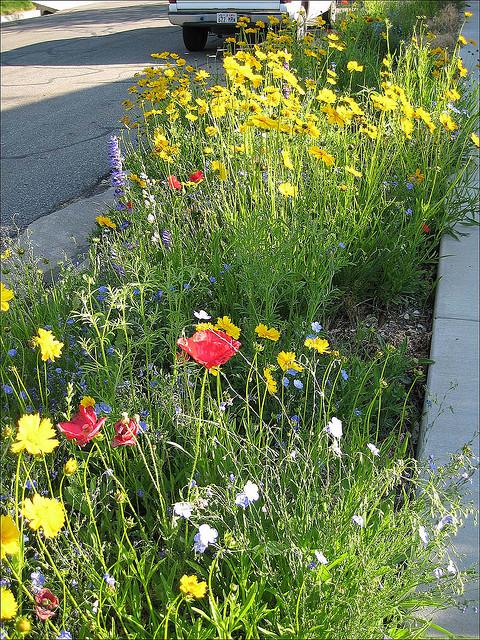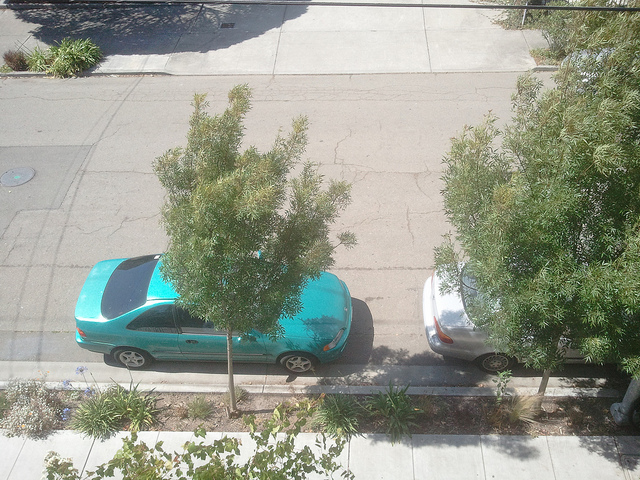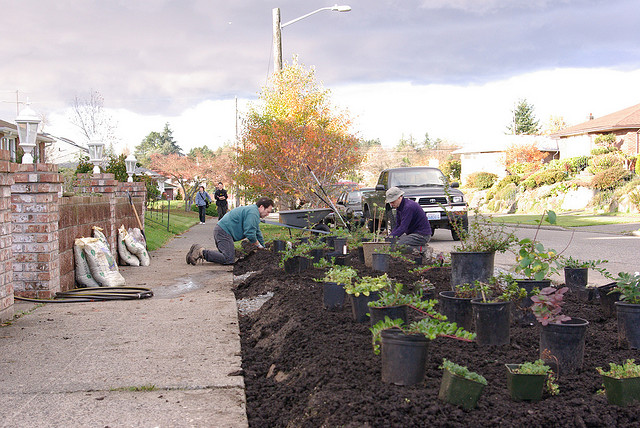Parking strips, the generally long, narrow strips between the street and sidewalk, can make plant selection more challenging.
Many types of plants are available for creating an attractive water-conserving parking strip. Plants should be selected for hardiness, sun exposure, soil and pollution tolerance, and mature size.
Many parking strips contain existing street trees. Consider the orientation of existing trees. Is there morning or afternoon shade under the trees? Are existing trees drought tolerant species? Selection of companion plants for planting under trees may vary considerably, depending on which side of the block the parking strip is located.
For instance, plants under trees on a south facing parking strip can be full sun species, depending on the height of the tree canopy. East facing parking strips with trees may only receive morning sun, so plants adapted to part shade should be used here.
Narrow Parking Strips
- Trees are generally not suitable for narrow park strips due to constraints on roots
- Water-wise turf species or gravel may be more suitable for narrow park strips. Choice of gravel color or size will influence its visual impact
- Carefully consider mature plant size when using shrubs and perennials for the park strip. Plants should not overpower the space or extend over the street or sidewalk
- Avoid planting many different species. This can look visually chaotic, especially if there is only one of each plant


Wide Parking Strips
- Street trees are suitable for wide park strips and are generally planted in urban neighborhoods to unify different architectural styles along city and neighborhood blocks
- Masses of appropriately sized perennials and shrubs can create strong visual impact
- Avoid too much of an open gravel or mulched area. It tends to look and feel sparse

Turf for Parking Strips
Pros:
- Easy to maintain
- Water-wise species available
Cons:
- Can look uninteresting in a solid mass
Groundcovers for Park Strips
Pros:
- Generally less than 24 inches tall
- Generally spreading and can be used to create a dense covering to help reduce annual weeds
- Available in a variety of types, forms, textures, and colors
- Are evergreen or deciduous
Cons:
- Can look boring if used in large masses
- Can be invasive depending on species selected
Perennials for Parking Strips
Pros:
- Available in a wide variety of forms, colors, textures
- Good selection of water-wise plants available in the trade
Cons:
- Can be high maintenance
- Can be invasive depending on species selected
Shrubs for Parking Strips
Pros:
- Attractive shapes, textures, and colors
- Can be fairly low maintenance depending on the species used
Cons:
- Can be high maintenance if pruning needs are high
Trees for Park Strips
Pros:
- Provide a sense of visual unity among city or neighborhood blocks
- Provide shade along sidewalks
Cons:
- Roots can heave sidewalks
- Can be messy depending on species selection
- High maintenance for power lines
- Can be invasive depending on species
Resources: Water Wise Plant Choices
Colorado
Xeriscaping: Ground Cover Plants
Xeriscaping: Trees and Shrubs
Ornamental Grasses
